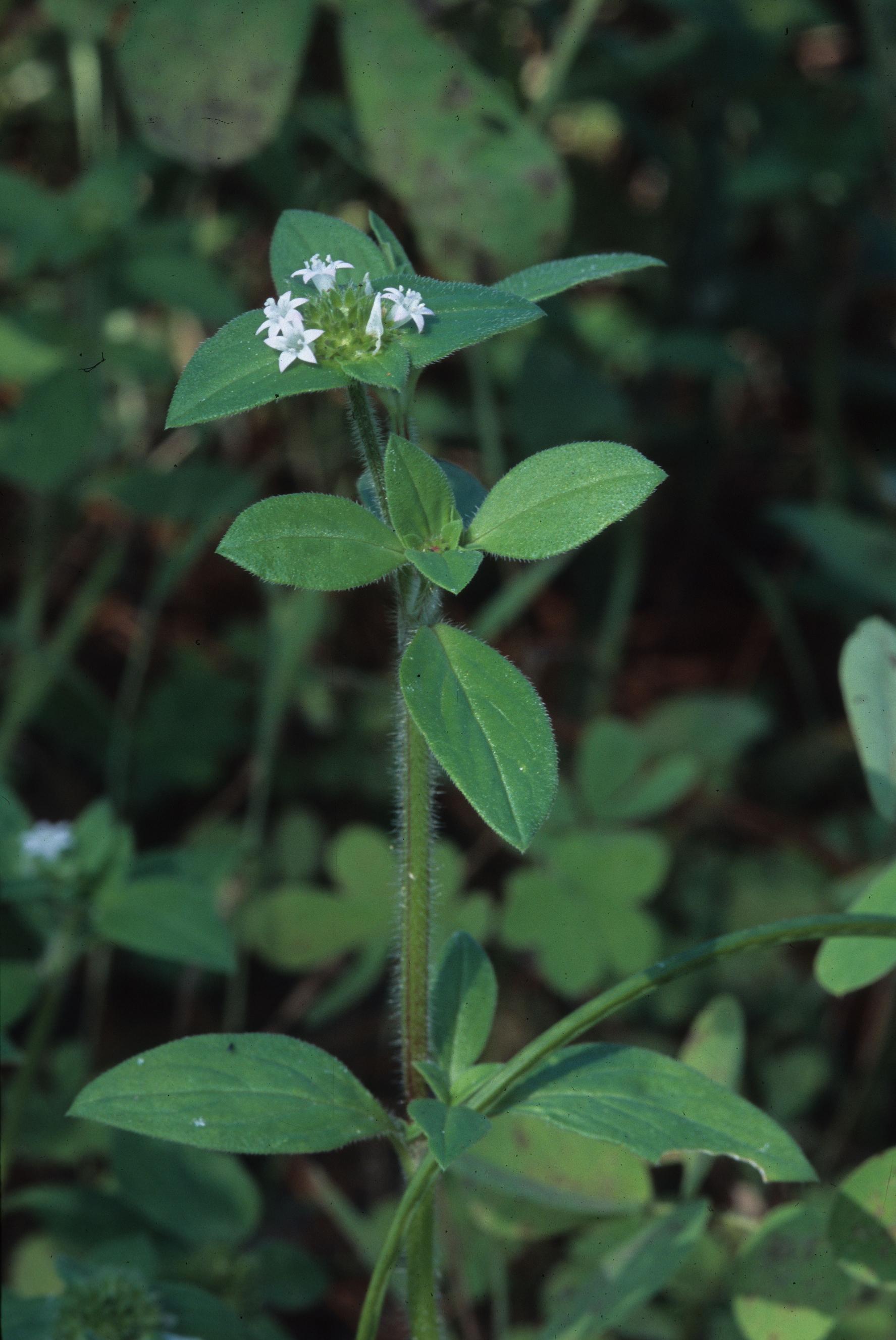Richardia scabra
| Richardia scabra | |
|---|---|

| |
| Photo was taken by Gil Nelson | |
| Scientific classification | |
| Kingdom: | Plantae |
| Division: | Magnoliophyta – Flowering plants |
| Class: | Magnoliopsida – Dicotyledons |
| Order: | Rubiales |
| Family: | Rubiaceae |
| Genus: | Richardia |
| Species: | R. scabra |
| Binomial name | |
| Richardia scabra L. | |

| |
| Natural range of Richardia scabra from USDA NRCS Plants Database. | |
Common names: Rough Mexican flower[1], Rough Mexican clover
Contents
[hide]Taxonomic notes
Description
"Diffuse, decumbent, pubescent to pilose annuals or perennials, the stem 1-7 dm long or tall. Leaves opposite, connected by fimbriate stipules, lanceolate to elliptic or weakly oblanceolate, 2.5-7 cm long including the often indehiscent petioles, 1-2 cm wide. Inflorescences terminal, glomerate, involucrate, the bracts ovate or widely ovate-lanceolate, often dimorphic; corolla white, funnelform, lobes shorter than tube, anthers inserted at the rim of the tube. Fruit leathery, 3-4 mm long, separating into 4 in dehiscent carpels." [2]
"Annual. Corolla 5-6 mm long, lobes less than 1/3 the length of the tube. Fruit tuberculate." [2]
Distribution
It is observed in South Carolina Coastal Plain. [3]
Ecology
Habitat
In the Coastal Plain region, R. scabra can be found in woodlands and upland pine communities. [4] It can also be found in vacant lots, roadsides, abandoned fields, and powerline corridors. [4] [1] It grows in fine sandy loams, that are poorly drained with slow permeability. [3] R. scabra does not respond to soil disturbance by clearcutting and chopping in North Florida flatwoods forests.[5]
Phenology
R. scabra has been observed flowering in March, May, and from June through December.[1][6]
Pollination
Deyrup observed these bees, Agapostemon splendens, Augochloropsis sumptuosa, Anthidiellum maculatum rufimaculatum, Megachile mendica, M. texana, Apis mellifera, and Bombus pennsylvanicus, on R. scabra. [7]
The following Hymenoptera families and species were observed visiting flowers of Richardia scabra at Archbold Biological Station: [8]
Apidae: Apis mellifera, Bombus pennsylvanicus
Halictidae: Agapostemon splendens, Augochloropsis sumptuosa, Lasioglossum lepidii
Megachilidae: Anthidiellum notatum rufomaculatum, Megachile mendica
Sphecidae: Ammophila pictipennis, Cerceris tolteca, Prionyx thomae, Stictia carolina, Tachytes pepticus
Vespidae: Leptochilus republicanus, Parancistrocerus salcularis rufulus
Use by animals
Richardia scabra was heavily fed on by Gopher tortoises in agricultural areas of southwestern Georgia. [9]
Conservation and management
Cultivation and restoration
Photo Gallery
References and notes
- ↑ Jump up to: 1.0 1.1 1.2 Nelson, Gil. Atlantic Coastal Plain Wildflowers: A Field Guide to the Wildflowers of the Coastal Regions of Virginia, North Carolina, South Carolina, Georgia, and Northeastern Florida. Guilford, CT: FalconGuide, 2006. 159. Print.
- ↑ Jump up to: 2.0 2.1 Radford, Albert E., Harry E. Ahles, and C. Ritchie Bell. Manual of the Vascular Flora of the Carolinas. 1964, 1968. The University of North Carolina Press. 981. Print.
- ↑ Jump up to: 3.0 3.1 Lewis, C. E. and T. J. Harshbarger. 1976. Shrub and herbaceous vegetation after 20 years of prescribed burning in the South Carolina coastal plain. Journal of Range Management 29:13-18.
- ↑ Jump up to: 4.0 4.1 Florida State University Robert K. Godfrey Herbarium database. URL: http://herbarium.bio.fsu.edu. Last accessed: July 2015. Collectors: : R. Komarek, Robert K. Godfrey, Andre F. Clewell, R. A. Norris, Loran C. Anderson, Edwin L. Tyson, D. E. Breedlove, Peter H. Raven, K E Blum, J. Dwyer, H. Loftin, Edwin L. Tyson, C. Kupfer, H. Smith, G. Martinez Calderon. States and Counties: Florida: Leon, Lafayette, Liberty. Georgia: Baker, Thomas. Country: Panama, Mexico. Compiled by Tall Timbers Research Station and Land Conservancy.
- Jump up ↑ Moore, W.H., B.F. Swindel, and W.S. Terry. (1982). Vegetative Response to Clearcutting and Chopping in a North Florida Flatwoods Forest. Journal of Range Management 35(2):214-218.
- Jump up ↑ Nelson, G. PanFlora: Plant data for the eastern United States with emphasis on the Southeastern Coastal Plains, Florida, and the Florida Panhandle. www.gilnelson.com/PanFlora/ Accessed: 13 DEC 2016
- Jump up ↑ Deyrup, Mark, Jayanthi Edirisinghe, and Beth Norden. 2002. The Diversity and Floral Hosts of Bees at the Archbold Biological Station, Florida (Hymenoptera: Apoidea). Insect Mundi 16.1-3: 87-120.
- Jump up ↑ Deyrup, M.A. and N.D. 2015. Database of observations of Hymenoptera visitations to flowers of plants on Archbold Biological Station, Florida, USA.
- Jump up ↑ Garner, J. A. and J. L. Landers. 1981. Foods and habitat of the gopher tortoise in southwestern Georgia. Proceedings of the Annual Conference of the Southeastern Association of Fish and Wildlife Agencies 35:120-134.